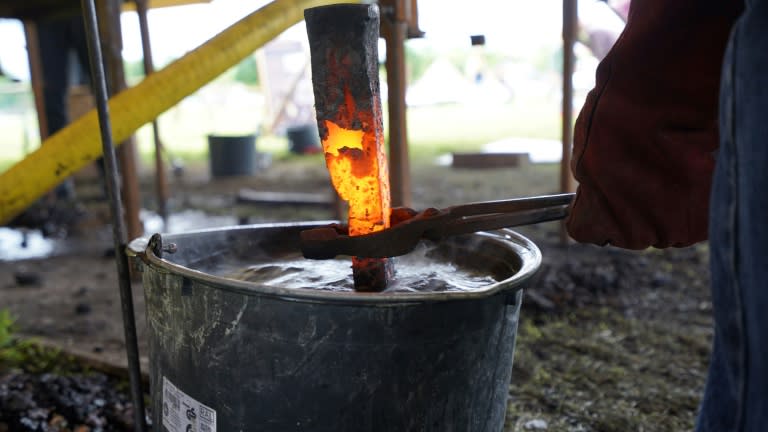In Denmark, blacksmiths steer journey into Viking ship's past

The clang of hammer on metal rings out across the Danish fjord as sweating blacksmiths work to painstakingly recreate an anchor that once hung from a Viking longship 1,000 years ago.
Their efforts are part of a project to seek out the seafaring secrets of those Scandinavian sailors by reconstructing the boats they crossed the seas in.
In the heat of their raging forge, the team from the UK's National School of Blacksmithing is helping to rebuild the "Skudelev 5," whose remnants are on display in nearby Roskilde's Viking Ship Museum.
"As close as possible, we're exploring the techniques that would have been used at the time," blacksmithing lecturer Rowan Taylor told AFP over the sound of his students banging away at red-hot iron.
Along with four other boats, the "Skudelev 5" was found in the Roskilde Fjord in 1962, almost a thousand years after it was sunk while trying to protect the town from invading marauders.
The archaeologists believe the sleek and slender ship was once part of a larger war fleet.
At 17 metres long, it is dwarfed by the largest Viking longship ever unearthed, the 37-metre-long "Roskilde 6" found nearby.
Roughly half of her oak hull survived, but her iron anchor did not.
For their reconstruction, the blacksmiths have had to model their work on another anchor dating from the same period.
That anchor, which was found in Ladby in central Denmark, measures 1.26 metres long by 0.83 metres wide and was lashed to its boat by an 11-metre-long chain.
"Access to resources for them was a lot harder than it was for us," 28-year-old apprentice blacksmith Michael Phillips mused.
"It really starts to put into light the ability they must have had," he added.
Once completed, which the blacksmiths hope will take six days, their ironwork will dangle from the side of a reconstruction of the "Skudelev 5".
The longship is expected to be fully restored to its former glory in 2028.
- Window to the past -
Since the 1980s, the Viking Ship Museum has been reconstructing ships from the period using experimental archaeological techniques.
The museum then puts the ships on display to the public -- or even out on the water.
For historians, the process of recreation provides a more practical understanding of the past.
For example, reconstructing a Viking ship helps archaeologists estimate how fast it sailed, as well as how much cargo and how many weapons it could carry.
"It's a way to just unlock all the information that you have stored in these ships," curator Triona Sorensen told AFP.
Sorensen said that studying the ships in the museum was useful in finding out how old they were and what materials they were made from.
"But you don't have any idea of how they performed in reality" without setting sail in them, she said: "And that's what we're really interested in."
Between the 9th and 11th centuries, Scandinavian warriors sailed across Europe and as far as North America, pillaging, settling and trading.
"The ships are really what drives this whole expansion during the Viking Age, and what brings Scandinavia into the political scene in Europe at the time," Sorensen added.
"For us, ships are really the absolute core of the Viking Age."
str-cbw/sbk/gv

 Yahoo News
Yahoo News 
